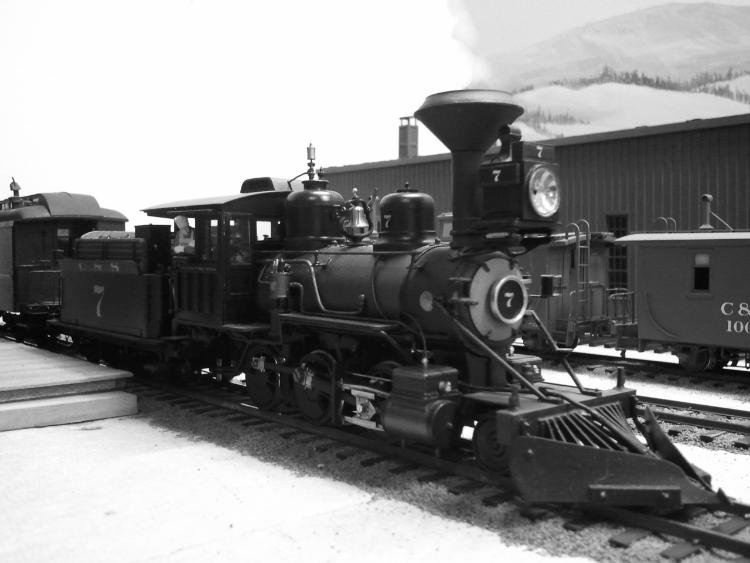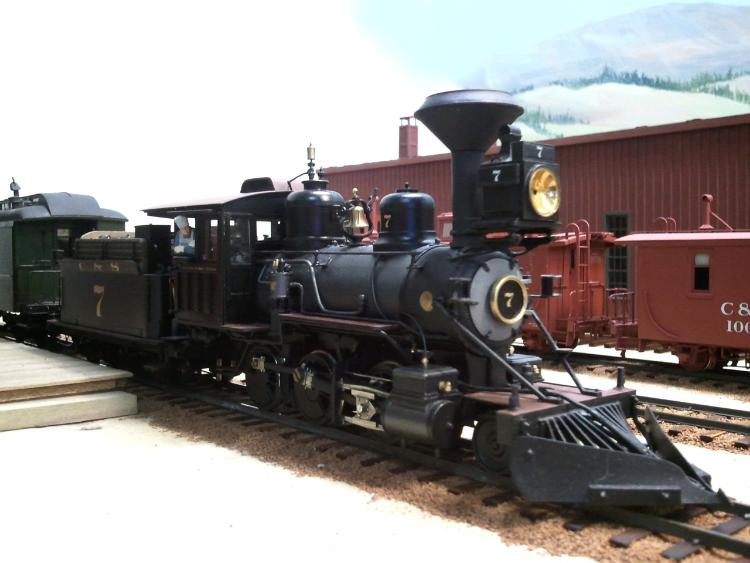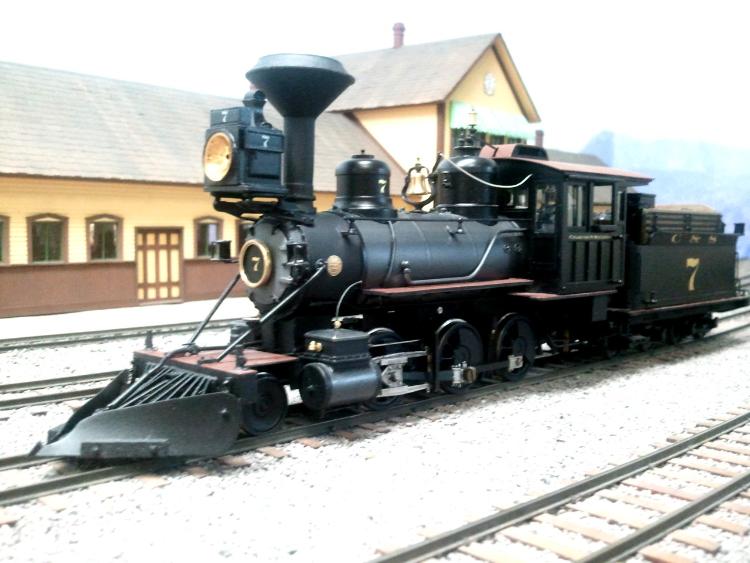C&S #7
|
Administrator
|
With the talk of #8 and her skiff plow and old South Park rock guards on the pilot, I thought there might be some interest in this On3 conversion of an ancient Balboa "DSP&P Cooke Mogul" into the first locomotive turned out by the Shops in Como in C&S Livery in 1899, #7.
I'll post this first in Black and White, as it appears in the only two known (at least to me) photographs we have of #7 before the 1902 rebuild, followed by the same photograph in color.  Thanks to invaluable assistance by Todd Hackett and David Christian Fletcher, who steered me in the direction that this locomotive had been painted in the style of the UP owned DL&G using on hand materials at Como, here is how #7 would have looked in 1899. Of this, I am absolutely certain, after careful study of that excellent photo with Pat Gibbony at Como.  Thanks also to my great long time friend Rob Smith, whose excellent work with his stunning early collection of DSP&P models, for inspiring this one. And a second mention to Todd Hackett for the artwork and printing of the decals. |
|
Administrator
|
This post was updated on .
There has been quite a debate over the years of how locomotives on the South Park were painted and finished in the early days, and I'm not going to venture any further down that road than what you see here.
In truth, I really don't think that a very serious arguement can be made that this is not how #7 appeared as it rolled out in all probability as the first Narrow Gauge engine in C&S Livery. I started out in the process of determining how this locomotive should be finished completely scoffing at the idea that it would be anything other than a monochromatic engine with very little actual color. The red, in every place it appears, including the edge of the floor below the tender tank, is evident in the original 1899 photograph, as is the unmistakable contrast of the domes to the jacketing. Over hours of careful study and emails with Todd in Denver and from David in OZ, this is what emerged. Following Todd's suggestion of using Testor's "Gunmetal Metalizer" (Buffing) paint for the jacketing, and David's suggestion of Tamya "Linoleum Deck Brown" as "UP Mineral Red", and actually following a photocopy of UP Locomotive paint Standards, it's obvious that the first C&S locomotive was much in appearance as a UP locomotive, right down to the Gold Leaf. Other changes to this locomotive include new rounded domes, a set of Overland cylinders and crossheads from the B-3-C project which I found on ebay, and an Overland #22 UP style smokebox front. The tender wrapper is all that remains from the Balboa tender. This engine is powered with a San Juan coreless motor and free floating drive, developed for their C-16 kit. It is the finest motor and drive system I have ever seen, or used by far. The upper part of the UP McConnell stack was provided by Rob, and is a cast urethane material that was apparently available some years back. The lower part of the stack is cut down from a PSC casting that is extremely close to what I needed. The box headlight was also modified from a PSC casting, mounted on what I believe are the original Cooke (Balboa) castings. The original Cooke style cab insert was removed and replaced with the more typical exposed slat style changed by the UP. Interestingly, (and I learned a lot with this project!) the tender trucks are just as the C&S used all the way through the B-4-F class, with the lone exception being that these have outboard brakes. There are numerous photos of this locomotive as DL&G #112 which helped enormously with this project, as most of the upgrades from the original occured in the late 1880's and 1890's. Rob and I have been collaberating on a similar project for several years now, which will be a model of C&S #22 of the same vintage as this one. In that project, which is being built from an equally ancient old PFM 2-6-0, it is actually being backdated to 1899, as this one required a lot of updating to 1899. I have that locomotive back now, and will keep you apprised as it gets further along. As soon as it is ready for paint, it will go back to Rob. One of the most interesting aspects of the #22, is the visual comparison of #7, which still retains it's original Cooke lines, to the 1894 UP total rebuilds of the old Brooks engines which became #'s 12, #13, #21, and #22. I promise some of you will be really surprised by some things. |
|
CONTENTS DELETED
The author has deleted this message.
|
|
Administrator
|
Thanks, John!
I'll incude a view of the other side of the engine. This was taken on another of my diorama sections, this one of the Durango Depot. So yes, another time, and another place, but what the Hell? There is a large box under the fireman's side of the cab, which I believe was used for oil and rags needed for the old headlight. This was also inspired from an old photo of #112, 
|
|
In reply to this post by Mike Trent
Mike
Looks great and that rock guard is sure interesting. Appreciate the additional historical info--the more I learn about the C&S the more intriguing it's becoming. William aka drgwk37 |
|
Administrator
|
Thanks, William. What you see on the model was a skiff plow which helped keep the line open with the passenger train in light snow conditions. You can see the bolt which attaches the wing of the plow to the actual rock guard, which was actually a heavy steel bar which extended out from the pilot to protect the cylinders from fallen rock.
|
|
Damn she's pretty!!!!
|
«
Return to C&Sng Discussion Forum
|
1 view|%1 views
| Free forum by Nabble | Edit this page |

